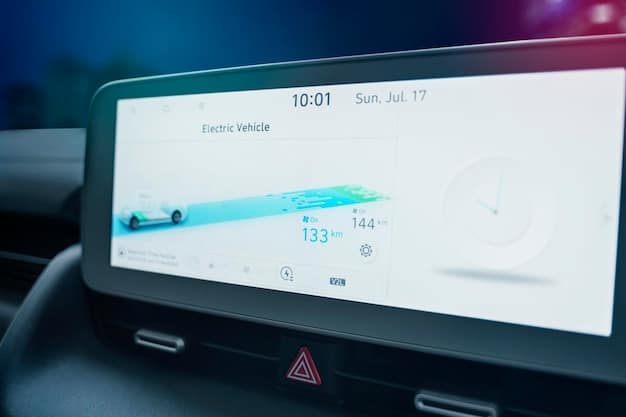Electric Vehicle Sales Surge: 40% Increase in US Adoption Last Quarter

Recent data reveals a significant surge in electric vehicle (EV) adoption across the United States, with sales increasing by an impressive 40% in the last quarter, signaling a major shift in consumer preferences and a growing demand for sustainable transportation solutions.
The latest data highlights a remarkable surge in electric vehicle sales surge: latest data shows a 40% increase in electric vehicle adoption across the US in the last quarter. This significant jump indicates a growing acceptance and demand for EVs among American consumers.
Electric Vehicle Revolution: Decoding the Sales Surge
The recent surge in electric vehicle sales in the United States is more than just a statistical anomaly; it represents a fundamental shift in the automotive industry. Understanding the dynamics behind this 40% increase requires a deeper look into the factors driving consumer adoption and the broader implications for the future of transportation.
Consumer Incentives and Government Policies
One of the primary drivers behind the EV sales surge is the availability of consumer incentives and supportive government policies. These initiatives make EVs more affordable and attractive to potential buyers.
Technological Advancements
Advancements in battery technology, charging infrastructure, and vehicle performance also play a crucial role in driving EV adoption. As EVs become more practical and convenient, more consumers are willing to make the switch.
- Improved Battery Range: The increased range of modern EVs reduces range anxiety, making them suitable for longer commutes and road trips.
- Faster Charging: Advancements in charging technology allow EVs to be charged more quickly, reducing downtime and enhancing convenience.
- Enhanced Performance: EVs now offer comparable or superior performance to traditional gasoline vehicles, with instant torque and smooth acceleration.
The combination of financial incentives, technological improvements, and growing environmental awareness has created a perfect storm for EV adoption in the US. As demand continues to rise, manufacturers are ramping up production and investing in new technologies to meet consumer needs.

Analyzing Regional Adoption Rates
While the national average for EV adoption is impressive, regional variations provide a more nuanced understanding of the market. Certain states and metropolitan areas are leading the charge, driven by local policies, infrastructure investments, and consumer preferences.
California’s Dominance
California continues to be the leading state for EV adoption, accounting for a significant portion of total US EV sales. This is due to the state’s aggressive emission standards, generous incentives, and extensive charging infrastructure.
Emerging Markets
Other states, such as Washington, Oregon, and Colorado, are also experiencing rapid growth in EV adoption. These states have implemented policies similar to California’s, fostering a supportive environment for EV ownership.
- Northeast Corridor: States along the Northeast Corridor, including New York and Massachusetts, are investing in charging infrastructure to support EV adoption in urban areas.
- Sun Belt States: States in the Sun Belt, such as Florida and Texas, are seeing increased interest in EVs as consumer awareness grows and prices become more competitive.
- Rural Areas: While adoption rates are lower in rural areas, initiatives to expand charging infrastructure and promote EV education are gaining traction.
Regional adoption rates reflect the diverse factors influencing consumer decisions. Understanding these variations is crucial for policymakers and manufacturers looking to accelerate EV adoption across the country.
The Impact of Charging Infrastructure
The availability and reliability of charging infrastructure are critical factors influencing EV adoption. A robust charging network not only supports current EV owners but also encourages more consumers to make the switch.
Public Charging Networks
Public charging networks, such as Tesla Superchargers, Electrify America, and ChargePoint, are expanding rapidly across the US. These networks provide convenient charging options for EV owners on the go.
Home Charging Solutions
Home charging solutions, such as Level 2 chargers, are also becoming increasingly popular. These chargers allow EV owners to conveniently charge their vehicles overnight, ensuring they are always ready to go.

The growth of charging infrastructure is essential for supporting the increasing number of EVs on the road. Investments in both public and private charging solutions are needed to ensure that EV owners have access to reliable and convenient charging options.
Economic Benefits of Electric Vehicle Adoption
Beyond environmental considerations, electric vehicle adoption offers significant economic benefits to both consumers and the broader economy. These benefits range from reduced fuel costs to job creation in the burgeoning EV industry.
Fuel Cost Savings
EV owners enjoy significant savings on fuel costs compared to traditional gasoline vehicles. Electricity is typically cheaper than gasoline, and EVs are more energy-efficient.
Maintenance Savings
EVs require less maintenance than gasoline vehicles, as they have fewer moving parts and do not require oil changes, spark plug replacements, or exhaust system repairs.
- Job Creation: The EV industry is creating new jobs in manufacturing, research and development, and infrastructure development.
- Energy Independence: By reducing reliance on foreign oil, EV adoption enhances energy independence and strengthens national security.
- Reduced Healthcare Costs: Cleaner air and reduced pollution can lead to improved public health outcomes, reducing healthcare costs associated with respiratory illnesses and other pollution-related diseases.
The economic benefits of EV adoption are substantial and far-reaching. As the EV industry continues to grow, these benefits will become even more pronounced, driving further investment and innovation.
Challenges and Opportunities in the EV Market
Despite the impressive growth in electric vehicle sales, several challenges remain. Overcoming these challenges is crucial for realizing the full potential of the EV market and ensuring a sustainable transportation future.
Supply Chain Constraints
Supply chain constraints, particularly the availability of critical minerals for battery production, pose a significant challenge to EV manufacturers. Diversifying supply chains and investing in domestic production are essential for mitigating these risks.
Charging Infrastructure Gaps
Gaps in charging infrastructure, particularly in rural areas and multi-unit dwellings, need to be addressed to ensure equitable access to EV charging. Public-private partnerships and innovative funding models are needed to fill these gaps.
Addressing these challenges requires collaboration among government, industry, and consumers. By working together, we can create a more sustainable and equitable transportation system for all.
Future Trends in the Electric Vehicle Market
The electric vehicle market is dynamic and rapidly evolving. Several key trends are shaping the future of EV technology and consumer adoption.
Advancements in Battery Technology
Continued advancements in battery technology will lead to longer ranges, faster charging times, and lower battery costs. Solid-state batteries and other next-generation technologies hold particular promise.
Autonomous Driving Integration
The integration of autonomous driving technology with EVs will further enhance convenience and safety. Self-driving EVs have the potential to transform transportation and reduce traffic congestion.
- Vehicle-to-Grid (V2G) Technology: V2G technology allows EVs to feed energy back into the grid, providing ancillary services and supporting grid stability.
- Subscription Models: Subscription models for EVs are becoming increasingly popular, offering consumers flexibility and affordability.
- Electric Trucks and SUVs: The introduction of electric trucks and SUVs is attracting a wider range of consumers, particularly those who prioritize utility and performance.
The future of the EV market is bright, with continued innovation and growing consumer demand driving further growth and adoption. By embracing these trends and addressing the remaining challenges, we can accelerate the transition to a cleaner and more sustainable transportation system.
| Key Point | Brief Description |
|---|---|
| 🚀 EV Sales Surge | US sees a 40% increase in EV adoption in the last quarter. |
| 💰 Incentives Impact | Government policies and consumer incentives boost EV affordability. |
| 🔋 Tech Advances | Improved battery range and faster charging propel EV adoption. |
| 🌎 Eco-Friendly Choice | Growing environmental awareness drives shift to electric vehicles. |
FAQ
▼
The surge is driven by a combination of factors like government incentives, technological advancements in battery range and charging speed, and increasing environmental awareness among consumers.
▼
California leads the way in EV adoption, followed by states like Washington, Oregon, and Colorado. These states have strong policies and infrastructure to support EV usage.
▼
The expansion of public and private charging networks is crucial. More accessible and reliable charging encourages more consumers to switch to EVs, reducing range anxiety.
▼
EV owners save on fuel and maintenance costs. EVs require less maintenance than gasoline cars, and electricity is typically cheaper than gasoline, resulting in overall savings.
▼
Challenges include supply chain constraints for battery components, gaps in charging infrastructure in rural areas, and the need for more diverse battery technologies to lower costs.
Conclusion
The 40% surge in electric vehicle adoption in the US signifies a turning point in the automotive industry, driven by technological advancements, policy support, and growing consumer awareness. While challenges remain in infrastructure and supply chains, the trend points towards a future where electric vehicles play a dominant role in transportation.





